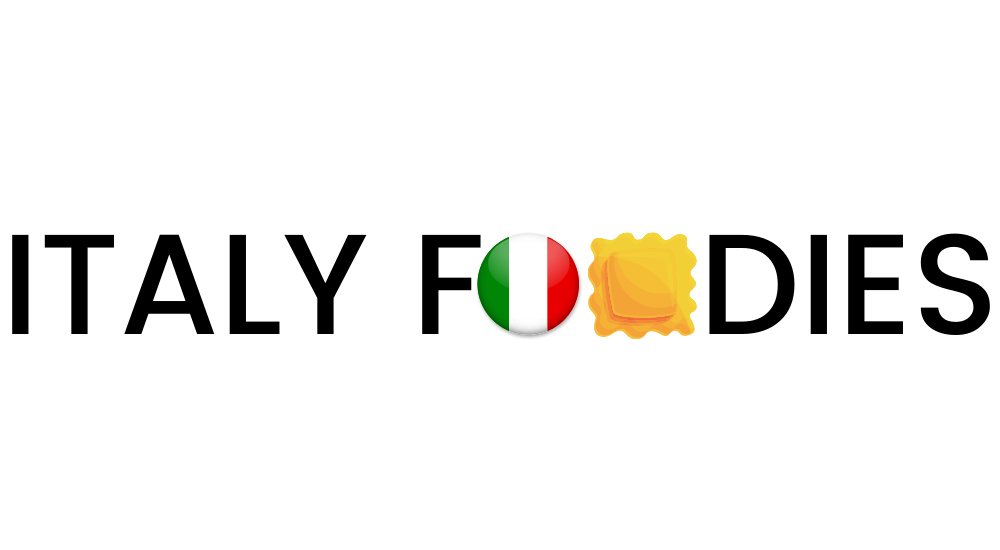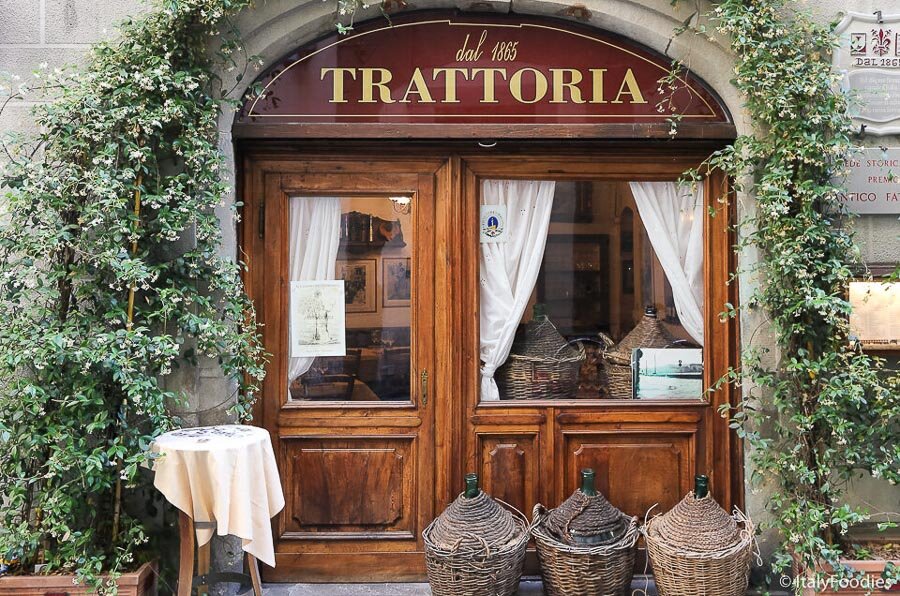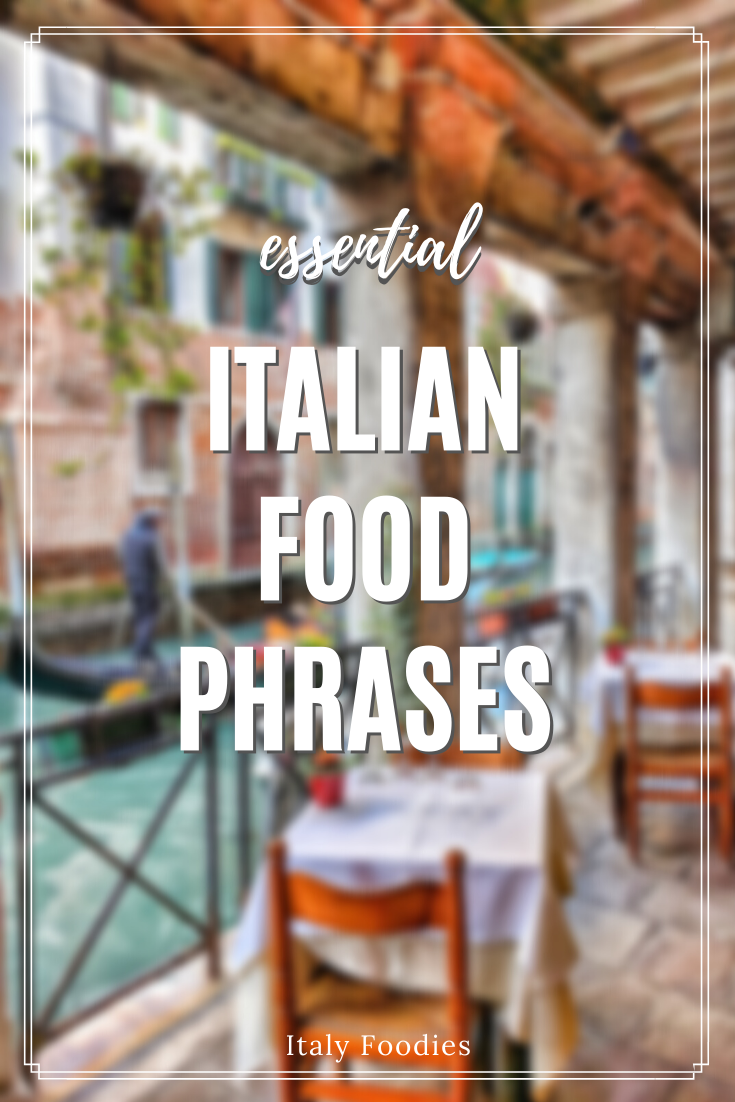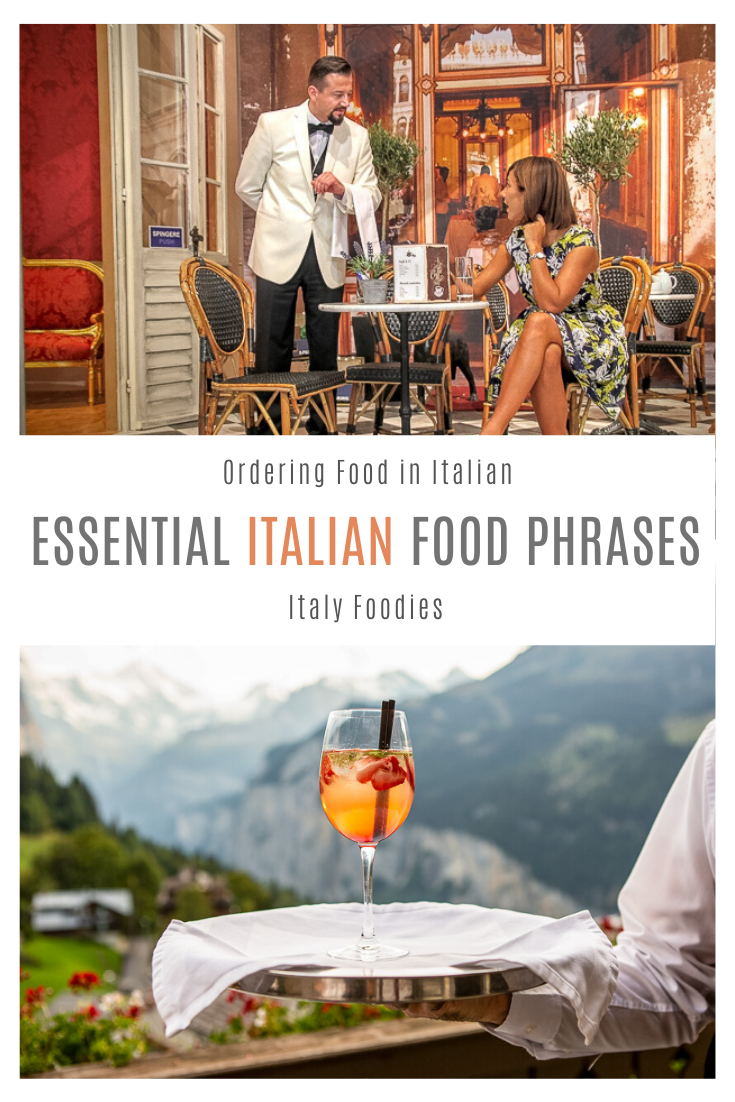The Essential Italian Food Phrases For Ordering Food and Wine in Italian
So you’re off to Italy as any good Italy Foodie would be, and it’s time to think about the little things — like hailing a cab, changing money, and ordering food in Italian. These tips and other important facts about Italy and food are essential!
If you’re on a group tour, chances are most of these details will be taken care of for you.
But if you’re traveling independently — even for parts of your trip — mastering these travel details can make your trip so much more enjoyable.
That’s especially true when it comes to food and wine. As you navigate Italy in search of traditional Italian food, this post will really come in handy.
As in any country there are rules of the road when dining whether you’re in a Michelin restaurant or at a walk-up on the street.
Whenever you order food, it goes without saying that using polite phrases helps to ease even the worst pronunciation or grammar, but at least they know you’re trying.
Using basic Italian phrases and words like Please, Thank You, and You’re Welcome go a long way.
You’ll also need some essential Italian food phrases too so you know how to order food in Italian, ask questions about the food, and be friendly with your waiter.
But first, a quick primer on restaurants in Italy, and what’s the difference between them, so you know your Trattoria from your Osteria!
This article may contain affiliate links. If you click through and make a qualifying purchase, we may earn a small commission at no additional cost to you.
Table of Contents
Types of Restaurants in Italy
Ordering Food in Italian
Basic Italian Phrases to Get You Started
Useful Phrases for Dining Out
How to Order Food in Italian
Types of Restaurants in Italy
Restaurants, Trattorias, and Osterias
There are primarily three types of restaurants in Italy: restaurants, trattorias, and osterias. There are also bars and enotecas which offer Italian drinks and cocktails, but that’s another story.
Traditionally, restaurants are formal and usually more expensive than the other two. A trattoria is less formal than the restaurant and may not have as many items on the menu as a restaurant. An osteria is the most casual of the three and will have the shortest menu.
But in today’s Italy there are trattorias that are a lot like restaurants and osterias that are a lot like trattorias. We have had some disappointing meals in some very nice restaurants and some amazing meals in trattorias and osterias.
Stroll through the dining scene in wherever you’re visiting and you’ll be able to tell the differences between the three in no time and pick your favorites.
Ordering Food in Italian
Traditional Italian Meal Courses
Navigating the menu in Italian restaurants and cafes can seem daunting at first. Even ordering street food from a non-English speaking vendor can be intimidating, enough to drive foodies to another more English-friendly food stand.
The way in which restaurant menus are presented to tourists in Italy can sometimes imply a certain process of ordering.
“Just because the menu in an Italian restaurant shows the various courses, doesn’t mean you have to order them all!”
This quote about Italian food was truly one of the most helpful things a waiter in Italy has ever said to me! lol
On our first trip to Italy years ago, we thought it might be improper or rude to not order according to the menu. The waiter laughed and said we must be really hungry! But then he added “it’s just a suggestion — order whatever you want”.
It helped me understand how Italians eat and that the process of ordering isn’t so confusing after all.
The order of courses is engrained in the Italian culture. It’s followed not only in restaurants, but also in Italian homes. But here’s the thing — just because the menu shows the various courses doesn’t mean you have to order them all!
Whew, pressure off! :-)
Aperitivo
These Italian drinks with alcohol are typically not strong and are drunk before eating to get your taste buds and tummy ready before you start to eat. Prosecco, Negroni, Aperol Spritz, and Vermouth are the most served aperitivo drinks.
Antipasto
This is simply appetizers and is what you’d expect. Usually salads, a charcuterie or Italian cheese plate, and sometimes a smaller portion of what is offered in the next two courses.
Primo
A first course that will be a stew or soup, think tortellini en brodo, pasta dishes, or a rice dish like risotto. This is the course where the carbs are served.
Secondo
Well this one’s easy to figure out. The second course features proteins, various meat or fish preparations. This is not like dining in the US. When you order from the Secondo you will get only what you ordered, a piece of meat or fish on the plate with no sides of vegetables.
Contorni
Are you a sides person like me? I could make a whole meal from just the side portions! These are the side dishes you’re looking for — most often veggies that are roasted or grilled, and sometimes steamed. You will never see pasta offered as a side dish. This is Italy and a full plate of pasta is a Primo course.
Dolci
Now comes the sweet part of your meal, dessert. On menus these come under different dessert sections. Torte means cakes but can also include pies and tarts. The literal translation of Dolci al Cucchiao is ‘spoon desserts’.
In this section there will be dishes like tiramisu and panna cotta. Gelati is Italy’s favorite ice cream. There might also be Semifreddi meaning ‘half frozen’ listed. These are partially frozen rich desserts with a creamy texture like mousse that will often have a drizzle of fruit or chocolate sauce.
Digestivo
These alcoholic drinks are what you order instead of milk. There are a variety of Digestivi and the Italians believe that consuming a digestivo after a meal actually helps digestion. Some of these drinks can be bitter, for example Amari, which is grape brandy infused with botanicals or spices and sweetened with a little sugar syrup.
In southern Italy, limoncello is the main digestivo of choice. We love it so much we developed our own Italian limoncello recipe and have been making it at home for years. Whiskey, rum, grappa, and cognac will be listed under Distillati.
Coffee
This one requires an explanation. In the US, coffee is generally served before or with dessert. Not so in Italy. Coffee is not served until after the dessert course. You’ll get the stink eye if you ask to have your coffee with dessert or it just won’t show up until the dessert plates are cleared.
COFFEE TIP: There’s a lot to know about the Italian coffee culture. For instance, Americans love cappuccino at any time of day, but in Italy cappuccino is considered a breakfast drink. Ordering a cappuccino after 11:00am or so screams that you’re a tourist.
Caffé Lattes fall into this category as well. Don’t do it! If you insist on a milk drink, order a macchiato instead which has just a touch of milk.
Why is this you ask? Italians believe that milk interferes with your digestion (something more people are starting to believe) so it is absolutely never consumed after the midday or evening meal.
Basic Italian Phrases to Get You Started
Before you head out, order a pocket-sized Italian phrasebook to take with you. You may use it, or you may not. But it’s something useful to read during down time on the train, or during solo dinners.
Plus — having a phrasebook in hand is often a good conversation starter if a local sees you trying to learn their language!
Master these simple phrases to get started:
Greetings
Greeting by time of day
Good morning or Good day - Buongiorno
Good afternoon or Good evening - Buonasera
Good night - Buonanotte
Hello and Goodbye - Ciao (informal), ciao ciao (informal) as in bye-bye
Please - Per favore
Thank you - Grazie
You’re welcome - Prego
Sorry - Mi dispiace
Good - Bene
Excuse me - Mi scusi; when passing in front of someone - Permisso
Useful Phrases for Dining Out
Do you speak English? - Parla inglese?
I don’t speak Italian? - Non parlo italiano
I don’t understand Italian - Non capisco l’italiano
How do you say _____ in Italian? - Come si dice _____ in Italiano?
Where are the toilets? - Dove sono i bagni?
TIP: One of the first things to do, either when making a reservation, being greeted by a Maitré d, or waitstaff member, is find out if they speak English.
In touristed areas most will speak enough English to help you along. But just in case……
Making a Dinner Reservation in Italy
How late are you open? — Quanto tardi sei aperto?
What time do you stop serving? — A che ora smetti di servire?
I’d like to reserve a table for (number in party) at (time) o’clock. — Vorrei riservare un tavolo per le (number) alle (time - 7, 8, 9, etc.).
If the reservationist doesn’t speak English, listen for either of these…..
Non abbiamo tavoli. — We have no tables.
È al completo. — We’re fully booked.
Special Needs / Accessibility
Do you have handicap access? — Hai accesso per disabili?
Is the restaurant handicap friendly? — É il ristorante adatto ai disabili?
Can you accommodate a wheelchair? — Puoi ospitare una sedia a rotelle?
Are the toilets handicap friendly? — Sono i servizi igienici per disabili?
“Life is too short, and I’m Italian.
I’d much rather eat pasta and drink wine than be a size 0. ”
When You Arrive
I’ve reserved a table. My name is (name). — Ho riservato un Tavolo. Sono (your name) - or - We did not reserve a table. — Non abbiamo riservato un tavolo.
Do you have a table for (number)? — Ha un tavolo per (number)?
How long is the wait? — Quanto dura l’attesa?
How to Order Food in Italian
With the preliminaries out of the way, you’re ready to be seated. You’re sure to be given a menu, but just in case you have to ask:
May we see the menu, please? — Possiamo vedere il menu, per favore?
Do you have an English menu? — Hai un menu inglese?
Water and Wine
In Italy (and many other countries too, but not so much in the US) water comes two ways — with or without gas. In South America, waiters may simply ask you “Con or Sin?” — with or without? In Italy, still water is referred to as naturale.
Sparkling water — Acqua con gas.
Still water — Acqua naturale.
May we have water please? — Possiamo avere acqua (con gas, naturale) per favore?
The Wine List
You’re in an Italian restaurant in Italy, so there’s no way you won’t be given a wine list. But if somehow it’s missed…..
The wine list, please. — La lista del vino, per favore.
What is a good wine? — Che cos'è un buon vino?
What wine do you recommend? — Che vino mi consigliate?
What is a good local wine? — Che cos'è un buon vino locale?
I’ll have a glass of red/white wine. — Prendo un bicchiere di vino rossa/ blanco.
A quarter/half-liter of the house wine. — Un quartino/mezzo litro di vino della casa.
I’d like a beer, please. — Vorrei una birra, per favore.
The Menu and Ordering
Menu vocabulary:
Chicken — Pollo
Pork — Maiale
Beef — Manzo
Salad — Insalata
Soup — La minestra
Salt and Pepper — Sale e pepe
Napkin — Tovagliolo
Spoon / Fork / Knife / Plate / Glass / Wineglass — Cucchiaio / Forchetta / Coltello / Piatto / Bicchiere / Bicchiere da Vino
Rare, medium rare, medium, well done — Raro, medio raro, medio, ben fatto
It’s decision time but you still have a few questions:
Do you have _____? — Hai _____?
I’ll have _____ — Avrò _____. - or - I’d like _____ — Vorrei _____.
What is the house specialty? — Qual è la specialità della casa?
May we have a few more minutes? — Potremmo avere ancora qualche minuto?
What comes with that? — Cosa ne deriva?
Is salad included? — È inclusa l’insalata?
What is that person having? — Che cosa ha quella persona?
What is the special of the day? — Qual'è il piatto del giorno?
What do you recommend? — Cosa raccomanda lei?
Do you have children’s portions? — Hai le porzioni dei bambini?
May we have some more bread, please? — Che possiamo avere del pane in più, per favore?
Is it hot or cold? — Fa caldo o freddo?
A little more please. — Ancora un po', grazie.
Enough, thank you. — Basta, grazie.
Special Dietary Needs
Does this dish contain wheat/ gluten/ nuts/ dairy/ shellfish? — Questo piatto contiene grano/ glutine/ noci/ latticini/ ai crostacei?
I’m vegan. — Sono vegetaliano.
Do you have any vegan dishes? — Hai dei piatti vegani?
Do you have any vegetarian dishes? — Hai dei piatti vegetariani?
Spicy is good. — Il piccante è buono.
Not too spicy. — Non troppo piccante.
Compliments and Complaints
The food was delicious. — Il cibo era delizioso.
The food was very good. — Il cibo era molto buono.
We really liked the _____. — Ci è piaciuto molto _____.
I didn’t order this. — Questo non l'ho ordinato.
This is uncooked/ stale/ cold/ too salty / overcooked / too spicy — Questo è crudo/ stantio/ freddo/ troppo salato/ troppo cotto/ troppo piccante
This isn’t fresh. — Questo non è fresco.
This spoon/ fork / knife / plate / glass is not clean. — Questo cucchiaio/ forchetta/ coltello/ piatto /bicchiere non è pulito.
The table is wobbly. — Il tavolo è traballante.
Paying the Bill
Can I pay with a credit card? — Posso pagare con una carta di credito?
Which credit cards do you accept? — Quali carte di credito accetti?
The bill, please. — Il conto, per favore. - or - Il conto, prego.
Is the service included in the bill? — Il servizio è incluso nel conto?
What is this amount for? — A cosa serve questo importo?
There’s a mistake in the bill. — C'è un errore nel conto.
Keep the change. — Tenga il resto.
TIP: Ask what is accepted as payment when making the reservation or when you arrive. Avoid a possible disaster or embarrassment, and don’t wait until the end of your meal.
If you don’t see credit card stickers on the door or window at the entrance to the restaurant, ASK! We’ve had the experience that even when there are stickers, the restaurant may no longer accept those particular cards.
This list of Italian food phrases is by no means exhaustive. What phrases have you used that we should add?
Like many countries, Italy has different dialects and colloquial phrases from region to region. So depending on where you are visiting, these phrases may not be completely understood, but they’ll get the gist. And it shouldn’t stop you from trying.
Besides, it’s fun and a good way to immerse yourself a little further into the culture which is always a good thing. The people you are trying to communicate with will smile and be more than willing to help you with vocabulary and pronunciation.
Just ask. It goes a long way in a slow travel experience!













